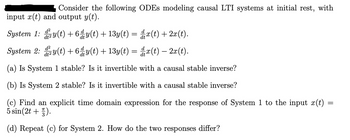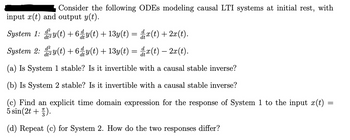
Introductory Circuit Analysis (13th Edition)
13th Edition
ISBN: 9780133923605
Author: Robert L. Boylestad
Publisher: PEARSON
expand_more
expand_more
format_list_bulleted
Question
please have step by step solution

Transcribed Image Text:Consider the following ODEs modeling causal LTI systems at initial rest, with
input x(t) and output y(t).
System 1: y(t) +6dy(t) + 13y(t) =
d²
System 2: y(t)+6y(t) + 13y(t) =
x(t) + 2x(t).
x(t) — 2x(t).
(a) Is System 1 stable? Is it invertible with a causal stable inverse?
(b) Is System 2 stable? Is it invertible with a causal stable inverse?
(c) Find an explicit time domain expression for the response of System 1 to the input x(t)
5 sin(2t+1).
(d) Repeat (c) for System 2. How do the two responses differ?
=
Expert Solution
This question has been solved!
Explore an expertly crafted, step-by-step solution for a thorough understanding of key concepts.
Step by stepSolved in 5 steps with 7 images

Follow-up Questions
Read through expert solutions to related follow-up questions below.
Follow-up Question
please do part d and check part c again. i dont think y(t) should be that long. is there anothere way to do it or simply it. again step by step soliutions and explain

Transcribed Image Text:Consider the following ODEs modeling causal LTI systems at initial rest, with
input x(t) and output y(t).
System 1: dy(t) +6ª y(t) + 13y(t) = ₫ x(t) + 2x(t).
System 2:
d2
y(t) +6ª y(t) + 13y(t) = x(t) — 2x(t).
(a) Is System 1 stable? Is it invertible with a causal stable inverse?
(b) Is System 2 stable? Is it invertible with a causal stable inverse?
(c) Find an explicit time domain expression for the response of System 1 to the input x(t)
5 sin(2t+1).
(d) Repeat (c) for System 2. How do the two responses differ?
Solution
by Bartleby Expert
Follow-up Questions
Read through expert solutions to related follow-up questions below.
Follow-up Question
please do part d and check part c again. i dont think y(t) should be that long. is there anothere way to do it or simply it. again step by step soliutions and explain

Transcribed Image Text:Consider the following ODEs modeling causal LTI systems at initial rest, with
input x(t) and output y(t).
System 1: dy(t) +6ª y(t) + 13y(t) = ₫ x(t) + 2x(t).
System 2:
d2
y(t) +6ª y(t) + 13y(t) = x(t) — 2x(t).
(a) Is System 1 stable? Is it invertible with a causal stable inverse?
(b) Is System 2 stable? Is it invertible with a causal stable inverse?
(c) Find an explicit time domain expression for the response of System 1 to the input x(t)
5 sin(2t+1).
(d) Repeat (c) for System 2. How do the two responses differ?
Solution
by Bartleby Expert
Knowledge Booster
Learn more about
Need a deep-dive on the concept behind this application? Look no further. Learn more about this topic, electrical-engineering and related others by exploring similar questions and additional content below.Similar questions
- I need answer within 20 minutes please please with my best wishesarrow_forwardPlz what is the methods of this circuit. ALL methods Plz.arrow_forward1-1.1 A six-cell storage battery having a nominal terminal voltage of 12 V is connected in series with an ammeter and a resistor labeled 6 S2. PROBLEMS 39 a) List as many random quantities as you can for this circuit. b) If the battery voltage can have any value between 10.5 and 12.5, the resistor can have any value within 5% of its marked value, and the ammeter reads within 2% of the true current, find the range of possible ammeter readings. Neglect ammeter resistance. c) List any nonrandom quantities you can for this circuit.arrow_forward
- Plz answer this ASAP Two resistors 15 and 20 respectively are connected in parallel and then connected in series with a resistor 10 2. The resistor circuit is connected to the terminal voltage X Volts. X=110 volts A.)Make an electrical circuit B.)Calculate the current flowing through each resistor.arrow_forwardPlease answer in typing format solution pleasearrow_forward
arrow_back_ios
arrow_forward_ios
Recommended textbooks for you
 Introductory Circuit Analysis (13th Edition)Electrical EngineeringISBN:9780133923605Author:Robert L. BoylestadPublisher:PEARSON
Introductory Circuit Analysis (13th Edition)Electrical EngineeringISBN:9780133923605Author:Robert L. BoylestadPublisher:PEARSON Delmar's Standard Textbook Of ElectricityElectrical EngineeringISBN:9781337900348Author:Stephen L. HermanPublisher:Cengage Learning
Delmar's Standard Textbook Of ElectricityElectrical EngineeringISBN:9781337900348Author:Stephen L. HermanPublisher:Cengage Learning Programmable Logic ControllersElectrical EngineeringISBN:9780073373843Author:Frank D. PetruzellaPublisher:McGraw-Hill Education
Programmable Logic ControllersElectrical EngineeringISBN:9780073373843Author:Frank D. PetruzellaPublisher:McGraw-Hill Education Fundamentals of Electric CircuitsElectrical EngineeringISBN:9780078028229Author:Charles K Alexander, Matthew SadikuPublisher:McGraw-Hill Education
Fundamentals of Electric CircuitsElectrical EngineeringISBN:9780078028229Author:Charles K Alexander, Matthew SadikuPublisher:McGraw-Hill Education Electric Circuits. (11th Edition)Electrical EngineeringISBN:9780134746968Author:James W. Nilsson, Susan RiedelPublisher:PEARSON
Electric Circuits. (11th Edition)Electrical EngineeringISBN:9780134746968Author:James W. Nilsson, Susan RiedelPublisher:PEARSON Engineering ElectromagneticsElectrical EngineeringISBN:9780078028151Author:Hayt, William H. (william Hart), Jr, BUCK, John A.Publisher:Mcgraw-hill Education,
Engineering ElectromagneticsElectrical EngineeringISBN:9780078028151Author:Hayt, William H. (william Hart), Jr, BUCK, John A.Publisher:Mcgraw-hill Education,

Introductory Circuit Analysis (13th Edition)
Electrical Engineering
ISBN:9780133923605
Author:Robert L. Boylestad
Publisher:PEARSON

Delmar's Standard Textbook Of Electricity
Electrical Engineering
ISBN:9781337900348
Author:Stephen L. Herman
Publisher:Cengage Learning

Programmable Logic Controllers
Electrical Engineering
ISBN:9780073373843
Author:Frank D. Petruzella
Publisher:McGraw-Hill Education

Fundamentals of Electric Circuits
Electrical Engineering
ISBN:9780078028229
Author:Charles K Alexander, Matthew Sadiku
Publisher:McGraw-Hill Education

Electric Circuits. (11th Edition)
Electrical Engineering
ISBN:9780134746968
Author:James W. Nilsson, Susan Riedel
Publisher:PEARSON

Engineering Electromagnetics
Electrical Engineering
ISBN:9780078028151
Author:Hayt, William H. (william Hart), Jr, BUCK, John A.
Publisher:Mcgraw-hill Education,